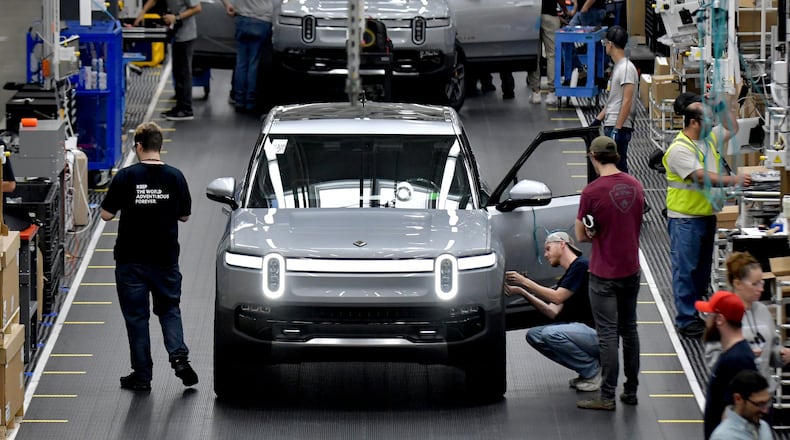Electric vehicle startup Rivian increased its revenues while trimming its losses in the second quarter compared to a year earlier — and company leaders boosted its manufacturing goal for this year as a result.
The California-based automaker reported $1.1 billion in revenue in the second quarter, compared to $364 million during the same period a year ago, a 208% increase. Rivian’s net loss for the quarter was $1.2 billion, down 30% from $1.7 billion a year ago.
The company assembled 13,992 battery-powered vehicles during the three months that ended in June, more than triple the number of vehicles it manufactured during last year’s second quarter. It’s also a 49% boost in production from the first three months of this year.
The increase prompted Rivian executives to increase its production goal to 52,000 units — a 2,000-vehicle bump from prior expectations. Simultaneously, the company predicts it will lose $100 million less than initially expected in 2023, a critical year for the startup that aims to stop bleeding cash and turn a profit by the end of next year.
“Our second-quarter results reflect our continued focus on cost efficiency as we accelerate the drive toward profitability,” Rivian CEO R.J. Scaringe said ahead of a Tuesday call with investors.
The second quarter was marred by an increased number of customers who had ordered a Rivian vehicle, changed their minds and decided not to purchase their reserved EVs. About $558 million in losses came from write-downs on the value of inventory, including canceled orders, which company executives said they expect to “decrease over time.”
Rivian ended the second quarter with $10.2 billion in cash reserves. The cash reserves will also help fund the company’s future $5 billion EV factory an hour east of Atlanta, where Rivian plans to launch its new line of R2 crossover SUVs. The company expects to reveal the new vehicle in early 2024.
The R2 will join the company’s flagship R1T pickup truck and R1S SUV, which Rivian has been manufacturing at its first facility in Normal, Illinois. The second quarter was the first time the company produced more SUVs than pickup trucks. Scaringe added that the SUV is the more profitable model.
“Over the long-term, we believe consumer mix will be heavily weighted toward the R1S,” the company said in a letter to shareholders. Competition among electric pickup trucks has heightened in recent months, while there are few three-row plug-in SUVs on the market.
Rivian had one of the biggest initial public offerings in U.S. history in 2021, with share prices peaking near $130 and the company’s evaluation surpassing $100 billion. Rivian’s stock plummeted last year as the company grappled with a semiconductor shortage, layoffs, recalls and lower-than-expected manufacturing numbers.
Share prices ended Tuesday slightly up at $24.80. Cox Enterprises, owner of The Atlanta Journal-Constitution, owns about a 4% stake in Rivian.
During the first three months of the year, Rivian paused production to incorporate new drive unit technologies at its Illinois plant, which allowed each vehicle to need half as many semiconductors. Sourcing chips had been a headache for production, and company executives credited the shift for the faster production clip.
“Increasing our production is the primary lever in our path to profitability,” the shareholder letter said. “The incorporation of our in-house drive units has played and will continue to play an instrumental role in improving our production ramp and cost structure.”
The R2, which is expected to begin production in Georgia in 2026, will use the same drive unit as a foundation, the company said. Rivian has yet to begin vertical construction on its 2,000-acre project site in southern Morgan and Walton counties, which is expected to open in 2025, though the site is being graded in preparation.
In exchange for the factory and 7,500 promised jobs, state and local officials offered Rivian an incentive package valued at $1.5 billion.
About the Author
Keep Reading
The Latest
Featured


